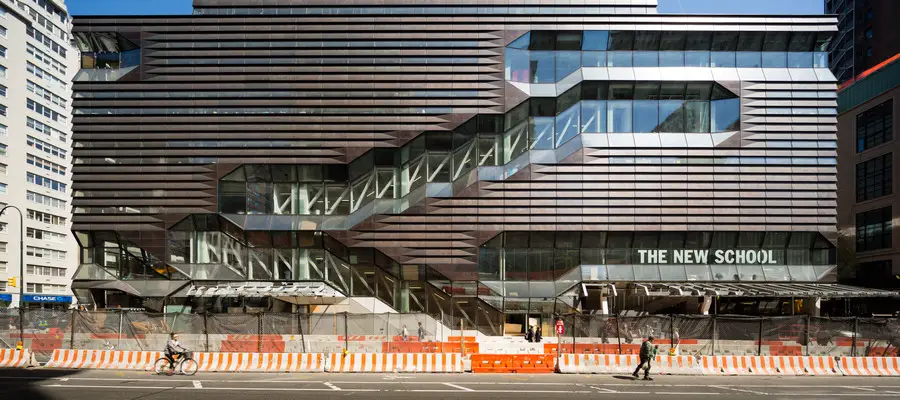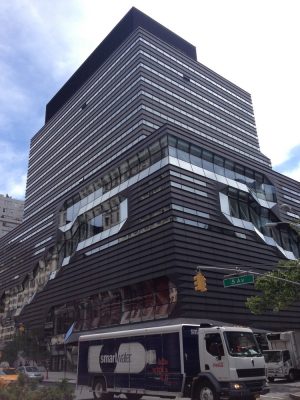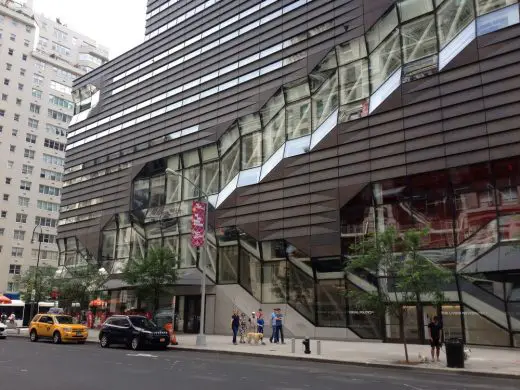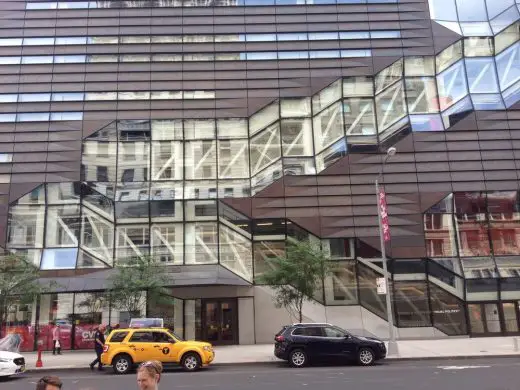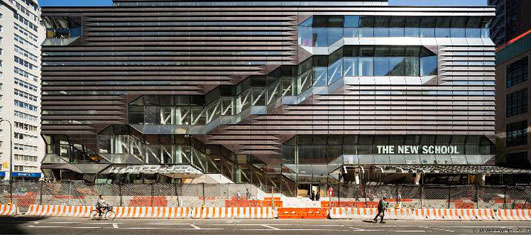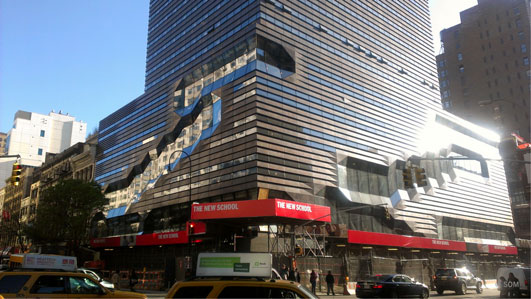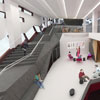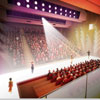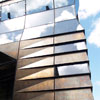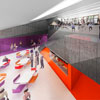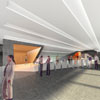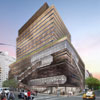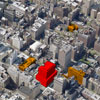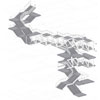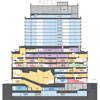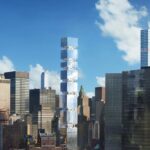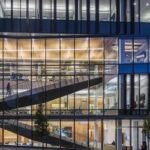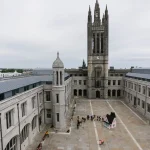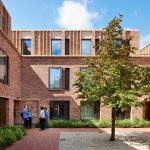University Center at The New School Manhattan building, NYC design photos
University Center at The New School
New York City Higher Education Building design by Skidmore, Owings & Merrill LLP, Architects, USA
Jul 3, 2016
The New School’s University Center
The New School’s University Center Building
Building images from 24 Jun – 2 Jul 2016 © Adrian Welch:
Feb 9, 2014
The New School’s University Center Building Opens
Design: Skidmore, Owings & Merrill LLP, Architects (SOM)
New York, NY: The official opening of The New School’s University Center, a striking new landmark for the school designed by Skidmore, Owings & Merrill LLP (SOM) took place recently in Manhattan.
Located at the intersection of Fifth Avenue and 14th Street, the 375,000-square-foot center reflects and reinforces the experimental nature of The New School and creates a dialogue between the campus community, the local neighborhood, and the city. The 16-story building houses design studios, laboratories, interdisciplinary classrooms, the main university library, a nine-floor student residence, an 800-seat auditorium, a café, and flexible academic and social spaces for student activity.
“The University Center transforms the traditional university environment,” explains Roger Duffy, FAIA, Design Partner at SOM. “Rather than compartmentalizing living and learning spaces, we strategically stacked these functions to create a vertical campus that supports the kind of interdisciplinary learning that has defined The New School since its founding.”
Connections between classrooms, studios, library, cafés, auditorium, and student residences take the form of stacked staircases and “sky quads” that facilitate the chance encounters vital to the cultivation of discussion and debate at The New School.
“The University Center boldly embodies The New School’s commitment to creativity, innovation, challenging to the status quo, and education through social engagement,” says David Van Zandt, president of The New School. “With its collaborative learning spaces, state-of-the-art performance spaces and studios, and striking exteriors, the University Center uniquely encourages experimentation, exchange, and engagement with our city and our world.”
A New Kind of Urban Campus
With its 230,000-square-foot, seven-story campus center (located in the building’s base) and 130,000-sqft residential tower, the University Center reimagines the organizing elements of a traditional campus, from quads to classrooms and living quarters. Vertical, horizontal, and diagonal campus pathways work together to facilitate movement through the building, while increasing opportunities for interaction among students and faculty from across the university. Academic spaces are flexible and easily adaptable, and can be renovated or reconfigured with no impact on power, data, or lighting to meet changing needs.
This innovative interior organization is expressed in the exterior of the building. Tightly woven, purpose-built spaces clad in hand-finished brass shingles contrast with the open connective tissue of the stairs and quads visible through a glazed skin. The exterior mediates between the cast-iron façades of the Ladies’ Mile Historic District to the north and the brownstones of the Greenwich Village Historic District to the south and west.
Pathways to Discussion and Debate
The University Center’s system of double stairways plays a critical role in the life of the building; it works in conjunction with skip-stop elevators to move large numbers of students vertically through the building. Stacked one above the other, the fire stair is designed for quick circulation, while the broader, open “communicating stair” allows for travel between floors at a more leisurely pace. With faceted walls clad in glass-fiber-reinforced concrete panels, the high-use stairways are a place for chance meetings between students and faculty, and encourage social interaction and interdisciplinary exchange.
Circulation paths that weave vertically, horizontally and diagonally through the building lead into and activate sky quads-interactive spaces that also orient users due to their adjacency to stairways and corridors. Like the “local” and “express” stairs that link them, the sky quads are intended to perform as social spaces, promoting formal and informal encounters between students and faculty, as well as supporting academic and leisure activities. These interactive spaces include student lounge areas, student resource centers with adjacent meeting rooms, study areas, cafés, and pin-up spaces for design studios.
To avoid crowded conditions and delays during class-change times in this vertical campus, peak elevator demand is mitigated through the combination of the intuitive system of stairways and a skip-stop elevator system. During peak times, the elevators stop at floors one, four, and six, and stairs are utilized to access the intermediate floors, while at off-peak times, the elevators stop at all floors.
Active Design Features
A central stair is the principle design feature in the University Center — a focal point both inside and outside the building. These stairs are intended as the principal means of circulation through the building for the physically able. Through the use of clerestory windows in hallways and on the façade, the University Center provides for daylighting along paths of travel, and the design is organized to encourage walking between destinations, as well as spaces for social interaction.
The building provides bike storage rooms and showers to encourage cycling, walking, and running between home and school. The building was recognized by Former Mayor Michael Bloomberg as a model of the successful implementation of the “active design” strategies that are part of New York City’s anti-obesity and health initiatives.
A Commitment to Sustainability and Energy Efficiency
Designed to meet LEED® Gold certification from the US Green Building Council, the University Center will set the New York City standard for green technology and building practices with super-efficient LED lights, occupancy sensors, a 265-kilowatt cogeneration plant, and sustainably sourced materials.
Envisioned as a model of energy efficiency, carbon reduction, and sustainability, the building anticipates 31 percent energy savings over a base-case school. Both passive and high-tech solutions increase energy efficiency. The envelope of the building is limited to 35 percent glass, to limit solar heat gain while still optimizing interior daylighting. The shingled cladding shades the windows up to 20 percent during daylight hours.
An ice-storage system, located in the second basement, uses electricity from the power grid during off-peak times to freeze water in a series of chambers; the ice melts during the day, reducing consumption during peak times. Heat recovery wheels gather heat from exhaust air and help heat supply air, saving energy.
A green roof, funded in part by the New York City Department of Environmental Protection, mitigates the heat-island effect, as well as storm-water runoff, capturing water for both gray-and black-water treatment facilities in the building. Waterless urinals contribute to potable-water conservation. Composting is employed with an in-vessel composter in the cafeteria.
The building serves as a living element of the curriculum, providing on-site training to the next generation of green leaders to students in environmental studies, sustainability management, and urban design. Design elements that demonstrate architectural, structural, mechanical and green building strategies are visible through signage and working exhibits. Back-of-the-house systems have been transformed into instructional spaces for New School students and facilities staff, as well as for professional organizations and unions, who are expected to use the building for hands-on training.
Student Resources
A co-ed residential tower for more than 600 students occupies floors eight through 16 of the University Center. An amenity space on the lower level is accessible only by residents and consists of a large common room, art studios, an exercise facility with gym equipment, soundproof music practice rooms, a study hall, bicycle storage area, mailroom, and laundry room. The University Center has three dining areas: a 280-seat cafeteria on the second floor, an 80-seat library café on the seventh floor, and a 60-seat event café on the lower level off the entrance lobby and auditorium.
About Skidmore, Owings & Merrill LLP
Skidmore, Owings & Merrill LLP (SOM) is one of the leading architecture, interior design, engineering, and urban-planning firms in the world, with a 75-year reputation for design excellence and a portfolio that includes some of the most important architectural accomplishments of the 20th and 21st centuries. Since its inception, SOM has been a leader in the research and development of specialized technologies, new processes and innovative ideas, many of which have had a palpable and lasting impact on the design profession and the physical environment.
The firm’s longstanding leadership in design and building technology has been honored with more than 1,700 awards for quality, innovation, and management. The American Institute of Architects has recognized SOM twice with its highest honor, the Architecture Firm Award-in 1962 and again in 1996. The firm maintains offices in New York, Chicago, San Francisco, Los Angeles, Washington, D.C., London, Hong Kong, Shanghai, Mumbai, and Abu Dhabi.
About The New School
Founded in 1919, The New School was born out of principles of academic freedom, tolerance, and experimentation. Committed to social engagement, The New School today remains in the vanguard of innovation in higher education, with more than 10,000 undergraduate and graduate students challenging the status quo in design and the social sciences, liberal arts, management, the arts, and media. The New School welcomes thousands of adult learners annually for continuing education courses and calendar of lectures, screenings, readings, and concerts. Through its online learning portals, research institutes, and international partnerships, The New School maintains a global presence. Learn more at www.newschool.edu.
More at: http://www.som.com/news/the_new_schools_university_center_to_open_january_23#sthash.fpQq3hrk.dpuf
Jul 22 + 19, 2013
University Center at The New School, Manhattan
Mayor Bloomberg Highlights SOM’s University Center at The New School as a Model of Active Design
Design: Skidmore, Owings & Merrill LLP, Architects
The City of New York unveiled its active design initiative and chose the University Center at The New School as the backdrop. SOM’s design for the new building focuses on stairs rather than elevators as the principal means of vertical transportation, and the program is organized to encourage walking between destinations. The University Center at The New School will open in January 2014.
Project Description
Located at the intersection of 14th Street and 5th Avenue in Manhattan, this new, multipurpose facility is intended to become the “heart” of The New School. The building will provide space for all aspects of a traditional campus, with 200,000 square feet of academic space on the first seven floors and 150,000 square feet for a 600-bed dormitory on the levels above. Interactive spaces are dispersed vertically throughout the section to activate all levels of the building.
Tying them all together are three iconic fire stairs that are unraveled to weave their way through the building, providing ample opportunities to chance encounters and unstructured conversation. This structure creates hives of activity that are traced along the façade with large glass windows. The result is an architecture whose identity is completely intertwined with the University’s identity, making the two indistinguishable.
Between these interactive zones are long, loft-style spaces which house 50,000 square feet of design studios, classrooms, and computing labs. These spaces are flexible and easily adaptable. They can be renovated or reconfigured with no impact on power, data, or lighting.
The building also includes an 800-seat auditorium; a central library with distributed resource spaces throughout; a large cafeteria; a 2,200-square foot faculty resource room in addition to 15 faculty offices; three student lounges; and a lobby/café space on two levels, with provisions for music performances.
The extensive academic program includes 19 fashion studios, 17 drawing studios, 12 classrooms, and 7 science labs. Virtually all schools and departments of the University are represented in this building. Program adjacencies are intentionally planned to promote collaboration in research rooms and chance encounters within generous circulation and social spaces. The University Center is designed to LEED Gold standards and envisioned from the start to be a model for energy efficiency, carbon reduction, and sustainability.
Through a rigorous process of evaluating viable, cost-effective, and maintainable energy savings techniques, the project is anticipated to achieve a 31.16% reduction in energy use from ASHRAE 90.1 (2007) requirements. The integrated design approach–which included senior level engineering and facilities personnel from The New School, The Durst Organization, and the A/E team–utilizes both passive techniques and active technologies to increase energy efficiency and reduce the carbon footprint.
University Center at The New School NYC – Building Information
Owner: The New School
Developer: The Durst Organization
Architect: Skidmore, Owings & Merrill LLP, New York –
Roger Duffy, FAIA, Design Partner; Mark Regulinski, AIA, Managing Director; Chris McCready, AIA, Project Manager; Jon Cicconi, AIA, Senior Design Architect; Colin Koop, AIA, Senior Design Architect; Angelo Arzano, AIA, Senior Technical Coordinator; Kimberly Garcia, AIA, Technical Coordinator
Residential Architect: SLCE Architects
Construction Manager: Tishman
MEP Engineer: Cosentini Associates
Structural Engineer: DeSimone Consulting Engineers
Civil Engineer: Langan Environmental & Engineering Services
Lighting: Brandston Partnership
LEED Consultant: Buro Happold
NYSERDA Consultant: ADS Engineers
IT/AV/Security: Shen Milson Wilke
Vertical TransportationL Van Deusen Associates
Commissioning: Fulcrum
Blackwater System: Alliance Environmental
Energy Modeling: Buro Happold
Acoustics: Cerami Associates
Food Service: Cini Little
Facade Maintenance: Entek
Theater: Fisher Dachs Associates
Code Consulting & Expeditor: Milrose
Signage: Integral Reudi Baur Paris
Schedule & Cost Management: ProjectConsult
University Center at The New School images / information from Skidmore, Owings & Merrill LLP, Architects (SOM)
Address: The New School, 66 West 12th Street, New York, NY 10011, USA
New York City, USA
New York City Architecture
Contemporary New York Buildings
Manhattan Architecture Designs – chronological list
New York City Architecture Tours by e-architect
New York State Architecture Designs
Columbia University Campus
Design: Renzo Piano Building Workshop (RPBW) with SOM
50 United Nations Plaza
Design: Foster + Partners
Use Microsoft AZ-900: Practice Test Dumps.
Columbia University Medical Center
American Architecture Designs
American Architectural Designs – recent selection from e-architect:
Comments / photos for the University Center at The New School New York page welcome
Website: www.newschool.edu/university-center

